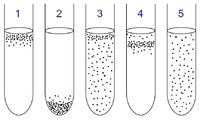
Photo from wikipedia
Oxygen transport membranes can enable a wide range of efficient energy and industrial applications. One goal of development is to maximize the performance by the improvement of the material, microstructural… Click to show full abstract
Oxygen transport membranes can enable a wide range of efficient energy and industrial applications. One goal of development is to maximize the performance by the improvement of the material, microstructural properties and operational conditions. However, the complexity of the transportation processes taking place in such commonly asymmetric membranes impedes the identification of the parameters to improve them. In this work, we present a sensitivity study that allows identification of these parameters. It is based on a 1D transport model that includes surface exchange, ionic and electronic transport inside the dense membrane, as well as binary diffusion, Knudsen diffusion and viscous flux inside the porous support. A support limitation factor is defined and its dependency on the membrane conductivity is shown. For materials with very high ambipolar conductivity the transport is limited by the porous support (in particular the pore tortuosity), whereas for materials with low ambipolar conductivity the transport is limited by the dense membrane. Moreover, the influence of total pressure and related oxygen partial pressures in the gas phase at the membrane’s surfaces was revealed to be significant, which has been neglected so far in permeation test setups reported in the literature. In addition, the accuracy of each parameter’s experimental determination is discussed. The model is well-suited to guiding experimentalists in developing high-performance gas separation membranes.
Journal Title: Membranes
Year Published: 2022
Link to full text (if available)
Share on Social Media: Sign Up to like & get
recommendations!